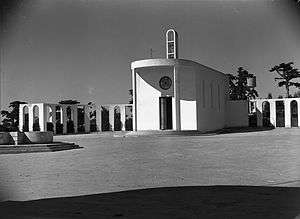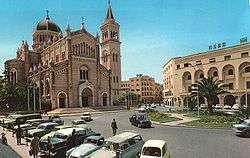Christianity in Libya
Christianity is a minority religion in Libya. Since Roman times it has always been present in Tripolitania and Cyrenaica.
Characteristics
The largest Christian group in Libya is the Coptic Orthodox Church (Copts in Libya), with a population of 60,000.[1] The Coptic Church is known to have historical roots in Libya long before the Arabs advanced westward from Egypt into Libya. However, the Roman Catholics have a large number as well, with 50,000[2] members. Orthodox communities other than that of the Egyptian Copts include the Russian Orthodox, Serbian Orthodox, and the Greek Orthodox. There is one Anglican congregation in Tripoli, made up mostly of African immigrant workers, that belongs to the Egyptian Anglican diocese. The Anglican bishop of Libya has his seat in Cairo.[3] There is also a priest in Sabha.[3]
There are relatively peaceful relations between Christians and Muslims in Libya. However, there are restrictions for Christian religious activity. It is prohibited to proselytize Muslims, even though a non-Muslim man must convert to Islam if he wants to marry a Muslim woman. Also, religious literature is restricted.
In spite of opposition to Christianity, a 2015 estimates some 1,500 Christian believers from a Muslim background residing in the country.[4]
Christian denominations
Coptic Orthodox Church
Currently, there are 60,000 Copts in Libya, as they have many roots in North Africa (primarily Egypt).[1]
Historically speaking, Christianity spread to the Pentapolis in North Africa from Egypt;[5] Synesius of Cyrene (370-414), bishop of Ptolemais, received his instruction at Alexandria in both the Catechetical School and the Museion, and he entertained a great deal of reverence and affection for Hypatia, the last pagan Neoplatonists, whose classes he had attended. Synesius was raised to the episcopate by Theophilus, patriarch of Alexandria, in 410. The Council of Nicaea in 325 made Cyrenaica an ecclesiastical province of the See of Alexandria. The Pope of Alexandria to this day includes the Pentapolis in his title as an area within his jurisdiction.[6]
The Coptic congregations in several countries were under the ancient Eparchy of the Western Pentapolis, which was part of the Coptic Orthodox Church for centuries until the thirteenth century.[7]
In 1971 Pope Shenouda III reinstated it as part of the Eparchy of Metropolitan Bishop Pachomius, Metropolitan of the Holy Metropolis of Beheira (Thmuis & Hermopolis Parva), (Buto), Mariout (Mareotis), Marsa Matruh (Paraetonium), (Apis), Patriarchal Exarch of the Ancient Metropolis of Libya: (Livis, Marmarica, Darnis & Tripolitania) & Titular Metropolitan Archbishop of the Great and Ancient Metropolis of Pentapolis: (Cyren), (Appollonia), (Ptolemais), (Berenice) and (Arsinoe).
This was one among a chain of many restructuring of several eparchies by Pope Shenouda III, while some of them were incorporated into the jurisdiction of others, especially those who were within an uncovered region or which were part of a Metropolis that became extinct, or by dividing large eparchies into smaller more manageable eparchies. This was also a part of the restructuring of the Church as a whole.
They are currently three Coptic Orthodox Churches in Libya: one in Tripoli, Libya (Saint Mark's), one in Benghazi, Libya (Saint Antonios — two priests), and one in Misrata, Libya (Saint Mary and Saint George).[8]
Roman Catholic Church


There are about 50,000 Roman Catholics, mostly Italian Libyans and Maltese Libyans.[2]
The Church of Santa Maria degli Angeli (Our Lady of the Angels) in the Old City - Medina of Tripoli was founded in 1645 and, with the permission of the Sultan of Constantinople, the Church of the Immaculate Conception was founded in Benghazi in 1858. Before World War II the number of Catholics increased in Libya due to Italian colonialism. The Catholic Cathedral of Tripoli (built in the 1930s) was converted to a mosque.[9]
Roman Catholic Vicariates Apostolic exist in Benghazi, Derna and Tripoli. There is a Prefecture Apostolic in Misrata.
There are two Bishops, one in Tripoli (Bishop Giovanni Innocenzo Martinelli - serving the Italian community in the Church of San Francisco in Dhahra).[10] and one in Benghazi (Bishop Sylvester Carmel Magro - serving the Maltese community in the Church of the Immaculate Conception).[11]
In Libya currently there are four territorial jurisdictions - three Apostolic Administrations and one Apostolic Prefecture:
- Apostolic Vicariate of Benghazi
- Apostolic Vicariate of Derna
- Apostolic Vicariate of Tripoli
- Apostolic Prefecture of Misrata
Pentecostals
There are Pentecostal worship groups in Libya in places like Tripoli and Benghazi. These churches are primarily worship groups who gather together every Friday, led by Pentecostal pastors. Though these groups are not officially approved by the government of Libya, they practice their faith without any interference from the government. The following are the two known Pentecostal worship places:
- Indian Prayer Fellowship, Tripoli
- Global Faith Fellowship, Misrata
Anti-Christian sentiment
In February 2014, east of Benghazi, seven Coptic Christians were dragged out of their houses in the middle of the night and shot dead execution-style by Islamic State of Iraq and the Levant (ISIS).[12]
On January 12, 2015, twenty-one Coptic Christians were abducted by forces of the ISIS.[13] On February 15, 2015 those 21 Christians were executed by ISIL shown in a video "A Message Signed with Blood to the Nation of the Cross."
On April 19, 2015, ISIS released another video in which they executed about 30 Ethiopian Christians.[14]
See also
| Christianity by country |
|---|
 |
|
|
|
|
Oceania
|
|
South America
|
|
|
- Christianity in Africa
- Coptic Orthodox Church
- Roman Catholic Church
- Roman Catholicism in Africa
- Religion in Libya
- Protestantism in Libya
- Christian Berbers
References
- Kjeilen, Tore. "Coptic Church". LookLex Encyclopedia. Archived from the original on 4 March 2016. Retrieved 30 January 2016.
- "History of the Catholic Church in Libya". Archived from the original on 2013-12-31. Retrieved 2011-01-07.
- Larkin, Barbara. International Religious Freedom 2000: Annual Report: Submitted By The U.S. Department Of State. Diane Pub Co. ISBN 0-7567-1229-7.
- Johnstone, Patrick; Miller, Duane Alexander (2015). "Believers in Christ from a Muslim Background: A Global Census". IJRR. 11 (10): 1–19. Retrieved 30 October 2015.
- "Britannica".
- "Coptic.net".
- History of the Coptic Church, by Father Menassa Youhanna
- Coptic Orthodox Church Listings for Libya (P. 136) Archived July 19, 2008, at the Wayback Machine
- Photos of Libyan catholic churches (in Italian) Archived January 9, 2011, at the Wayback Machine
- Islam and Christianity. The Unknown Side of Libya-Interview with Msgr. Giovanni Martinelli, Bishop of Tripoli Diocese Archived 2007-06-25 at the Wayback Machine
- "Untitled Document". www.ofm.org.mt.
- Editorial, Reuters. "Seven Egyptian Christians found shot execution-style on Libyan beach".
- "ISIS claim abduction of 21 Christians in Libya: activists". Agence France Presse. Daily Star Lebanon. January 12, 2015.
- IS releases new 'killing' video of Ethiopian Christians. 20 April 2015. BBC. Retrieved 16 June 2020.
External links
- Coptic History: Mission in the Church
- Coptic Church Listings for the Diaspora (P. 119)
- http://www.catholic-hierarchy.org/country/dly2.html
- United States Department of State
- http://www.ead.de/gebet/30tage/kalender.php?ausgabe=2006&tag=18 (in German)
- https://web.archive.org/web/20110721155439/http://www.globalfaithfellowship.in/